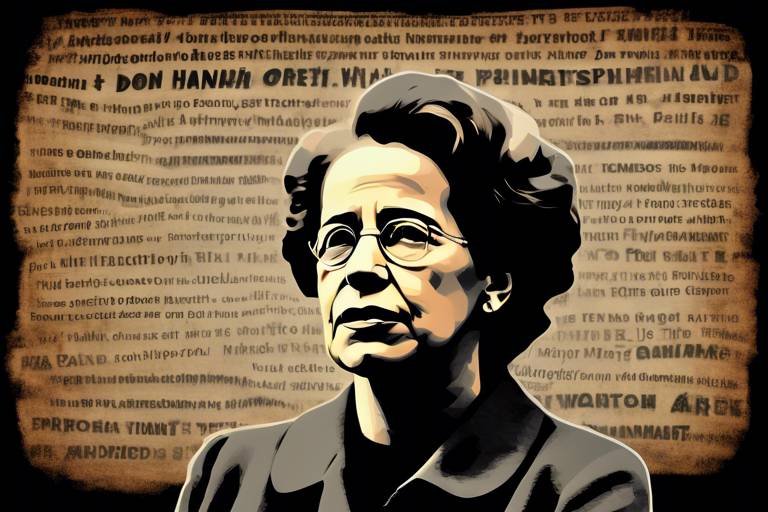The Politics and Philosophy of Social Movements
This article explores the intricate relationship between political ideologies and the philosophical underpinnings of social movements, highlighting their historical significance and contemporary relevance. Social movements are more than just collective actions; they represent the voice of the people, echoing their needs, aspirations, and frustrations. Often, they emerge in response to perceived injustices, demanding change and advocating for rights that are fundamental to human dignity. In a world that is constantly evolving, the politics and philosophies that drive these movements are equally dynamic, reflecting the complexities of society itself.
At the heart of social movements lies a profound quest for justice and equality. Whether it’s the fight for civil rights, gender equality, or environmental sustainability, these movements are fueled by a deep-seated belief that change is not only possible but necessary. They challenge the status quo, question existing power structures, and inspire individuals to come together for a common cause. This collective action is often rooted in shared experiences and a unified vision for a better future, making social movements a powerful force for transformation.
One of the most fascinating aspects of social movements is their ability to adapt and evolve. In the face of changing political landscapes and societal norms, movements often shift their strategies and philosophies to remain relevant. For instance, the rise of digital technology and social media has revolutionized how movements organize and mobilize support. Activists can now reach a global audience with just a few clicks, amplifying their messages and rallying supporters in unprecedented ways. This digital age has not only transformed communication but has also democratized activism, allowing voices that were once marginalized to be heard.
However, the journey of social movements is fraught with challenges. The path to achieving their goals is often met with resistance, backlash, and even repression. Activists must navigate a landscape filled with misinformation, hostility, and the risk of co-optation by mainstream narratives. Despite these obstacles, the resilience of social movements shines through. They continue to inspire change, foster solidarity, and create spaces for dialogue and understanding across diverse communities.
In conclusion, the politics and philosophy of social movements encapsulate a rich tapestry of human experience, reflecting our collective struggles and triumphs. As we delve deeper into the historical context, ideologies, mobilization strategies, and the impact of technology on these movements, we uncover the profound ways in which they shape our society and influence the future. Understanding these dynamics is crucial for anyone looking to engage with the pressing issues of our time and contribute to the ongoing fight for justice and equality.
- What are social movements? Social movements are organized efforts by groups of people to bring about social, political, or economic change. They often arise in response to perceived injustices or inequalities.
- How do social movements influence society? Social movements can influence society by raising awareness about issues, mobilizing public support, and pressuring governments or institutions to implement change.
- What role does technology play in social movements? Technology, especially social media, plays a crucial role in modern social movements by enabling rapid communication, organization, and outreach to a global audience.
- What is intersectionality in social movements? Intersectionality refers to the interconnected nature of social categorizations such as race, class, and gender, which can lead to overlapping systems of discrimination or disadvantage within social movements.

The Historical Context of Social Movements
To truly grasp the essence of social movements, we must travel back in time and explore the rich tapestry of history that has shaped them. Social movements are not just spontaneous eruptions of public sentiment; they are deeply rooted in the socio-political landscapes of their times. From the abolition of slavery to the civil rights movement, each pivotal event has left an indelible mark on the fabric of society, influencing countless others to rise in solidarity against oppression and injustice.
Consider the American Civil Rights Movement of the 1950s and 1960s. This powerful movement was not born in isolation; it was a response to centuries of systemic racism and segregation. Key figures like Martin Luther King Jr. and Rosa Parks emerged as beacons of hope, inspiring millions to fight for equality. Their strategies, rooted in nonviolent resistance, set a precedent for future movements, demonstrating the profound impact of leadership and ideology.
Similarly, the Women’s Suffrage Movement in the late 19th and early 20th centuries highlighted the struggle for gender equality. Women like Elizabeth Cady Stanton and Susan B. Anthony tirelessly campaigned for the right to vote, laying the groundwork for future feminist movements. Their efforts remind us that social movements often build upon the struggles of those who came before, creating a continuum of activism that evolves over time.
Moreover, the rise of labor movements during the Industrial Revolution illustrates how economic factors can catalyze collective action. Workers united to demand better wages, working conditions, and rights, leading to significant changes in labor laws and practices. These movements were often met with fierce resistance from those in power, yet they persisted, showcasing the resilience of individuals fighting for their rights.
In examining these historical contexts, we can see a pattern of interconnectedness among various movements. They often overlap and influence one another, creating a rich dialogue about justice and equity. For instance, the environmental movement has roots in earlier social justice movements, as activists began to recognize the disproportionate impact of environmental degradation on marginalized communities.
To further illustrate the historical evolution of social movements, consider the following table that outlines some of the major movements and their key impacts:
| Social Movement | Time Period | Key Achievements |
|---|---|---|
| Abolitionist Movement | 1830s-1865 | End of slavery in the United States |
| Civil Rights Movement | 1950s-1960s | Voting Rights Act, Civil Rights Act |
| Women’s Suffrage Movement | 1848-1920 | 19th Amendment (women's right to vote) |
| LGBTQ+ Rights Movement | 1960s-Present | Legalization of same-sex marriage, anti-discrimination laws |
| Environmental Movement | 1960s-Present | Legislation for clean air and water, climate action |
In conclusion, the historical context of social movements is a testament to humanity's enduring quest for justice and equality. By understanding the past, we can better appreciate the complexities of contemporary movements and the philosophical ideologies that drive them. Each movement tells a story, a narrative woven through the struggles and triumphs of those who dared to challenge the status quo. As we look towards the future, it’s crucial to honor this history and recognize the ongoing fight for social change.
- What are social movements? Social movements are organized efforts by groups of people to bring about social or political change.
- How do social movements influence society? They raise awareness about issues, mobilize public opinion, and often lead to significant legislative changes.
- What role does technology play in modern social movements? Technology, particularly social media, enhances communication and mobilization, allowing movements to reach a global audience quickly.
- Why is intersectionality important in social movements? Intersectionality acknowledges that individuals experience overlapping identities, which can affect their experiences of oppression and privilege, making inclusivity crucial for effective activism.

The Role of Ideology in Social Movements
Ideology serves as the backbone of social movements, acting as a guiding compass that shapes their objectives, strategies, and the means through which they rally support. This intricate relationship between ideology and social movements is not just a theoretical concept; it is a practical reality that has been witnessed across various movements throughout history. Without a strong ideological foundation, movements can lack direction, leading to fragmented efforts and diluted messages. Think of ideology as the DNA of a social movement; it defines what the movement is, what it stands for, and what it aims to achieve.
At its core, ideology provides a framework for understanding societal issues and articulating solutions. For instance, consider the different ideologies that have spurred various movements. Each ideology presents a unique lens through which activists view the world, influencing their approaches and the specific changes they advocate for. In this context, one can identify several prominent ideologies that have historically fueled social movements:
- Socialism: Focused on economic equality and the redistribution of wealth, socialist movements emphasize class struggle and advocate for systemic changes to address wealth disparities.
- Feminism: Centered on dismantling patriarchal structures, feminist movements strive for gender equality and the empowerment of women across all spheres of life.
- Environmentalism: Concerned with the health of our planet, environmental movements aim to protect natural resources and advocate for sustainable practices.
These ideologies not only articulate the problems at hand but also propose actionable solutions. For example, socialist movements argue for policies that redistribute wealth and resources to create a more equitable society. On the other hand, feminist movements challenge societal norms that perpetuate gender inequality, advocating for policies that ensure equal rights and opportunities for all genders. Similarly, environmentalists call for changes in policy and behavior to combat climate change and protect vulnerable ecosystems.
Moreover, the effectiveness of a social movement often hinges on its ability to resonate with the public. Ideologies that are relatable and address the immediate concerns of the populace tend to garner more support. This is where the art of storytelling comes into play. Movements that can weave compelling narratives around their ideological beliefs are more likely to attract attention and mobilize people. For instance, the civil rights movement in the United States was not just about ending segregation; it was about creating a vision of a society where people are judged by their character rather than the color of their skin. This narrative, deeply rooted in the ideology of equality and justice, inspired countless individuals to join the cause.
However, it's essential to recognize that ideologies can also lead to divisions within social movements. Different factions may emerge, each adhering to a particular interpretation of the ideology, which can create tension and hinder progress. Take the feminist movement, for example; while many advocate for gender equality, there are various strands, including liberal feminism, radical feminism, and intersectional feminism, each with its own focus and methods. This diversity can enrich the movement but can also lead to disagreements about priorities and strategies.
In conclusion, ideology plays a pivotal role in shaping social movements. It provides the necessary framework for understanding societal issues, articulating goals, and mobilizing support. As movements evolve, their ideological foundations may adapt, but the core principles often remain the same. Understanding these ideologies is crucial for anyone looking to engage with social movements, as they not only define the movements themselves but also the potential for societal change.
Q: What is the main purpose of ideology in social movements?
A: Ideology provides a framework for understanding societal issues and articulating solutions, guiding the objectives and strategies of social movements.
Q: Can ideologies within a social movement conflict with each other?
A: Yes, different factions within a movement may adhere to varying interpretations of the ideology, leading to potential divisions and disagreements about priorities and strategies.
Q: How do ideologies influence public support for social movements?
A: Ideologies that resonate with the public and address their immediate concerns are more likely to garner support, often through compelling narratives that inspire action.

Types of Ideologies
When we delve into the world of social movements, it's essential to recognize that they don't spring up in a vacuum; rather, they are deeply rooted in various ideologies that shape their goals and methods. Each movement has its own unique lens through which it views societal issues, and these ideologies serve as the driving force behind their actions. Let's explore some of the most prominent ideologies that fuel social movements today.
First, we have socialism, which focuses on the redistribution of wealth and the dismantling of class hierarchies. Socialist movements advocate for systemic changes that challenge the existing capitalist structures, aiming to create a society where resources are shared more equitably. This ideology emphasizes the importance of collective ownership and highlights the struggles of the working class against exploitation.
On the other end of the spectrum, we find feminism, which addresses gender inequalities and fights against patriarchal systems that have historically marginalized women. Feminist movements strive for gender equality across various sectors, including politics, education, and the workplace. They argue that true equality cannot be achieved until both men and women have equal opportunities and rights, challenging societal norms that perpetuate discrimination.
Another significant ideology is environmentalism, which advocates for the protection of the planet and its ecosystems. Environmental movements often intersect with social justice, recognizing that marginalized communities are disproportionately affected by environmental degradation. They call for sustainable practices and policies that not only protect the environment but also ensure that all people have access to clean air, water, and resources.
To further illustrate the diversity of ideologies within social movements, let’s look at a few more examples:
- Anti-racism: Focuses on combating racial discrimination and promoting equality for all races.
- LGBTQ+ Rights: Advocates for the rights and recognition of LGBTQ+ individuals, challenging heteronormative structures.
- Indigenous Rights: Centers on the rights of Indigenous peoples, emphasizing their sovereignty and connection to the land.
Each of these ideologies not only addresses specific societal issues but also offers unique solutions and perspectives. They often overlap, creating a rich tapestry of activism that reflects the complexities of our world. As these movements evolve, they adapt and incorporate new ideas, ensuring that they remain relevant in an ever-changing social landscape.
In summary, understanding the various ideologies that underpin social movements is crucial for grasping their motivations and strategies. Whether it's fighting for economic equality, gender rights, or environmental sustainability, these ideologies provide the framework through which activists interpret their struggles and mobilize support. As we continue to witness the rise of new movements, it's clear that the interplay of these ideologies will shape the future of activism in profound ways.
Q: What is the role of ideology in social movements?
A: Ideology serves as the foundation for social movements, guiding their objectives, strategies, and the ways they engage with supporters and the public.
Q: How do different ideologies intersect within social movements?
A: Many social movements incorporate multiple ideologies, recognizing that issues like race, gender, and class are interconnected, leading to a more inclusive approach to activism.
Q: Can social movements change their ideologies over time?
A: Yes, social movements often evolve and adapt their ideologies in response to new challenges, societal changes, and the needs of their communities.

Socialism and Class Struggle
Socialism, at its core, is a political and economic ideology that advocates for collective ownership and democratic control of the means of production. This ideology not only seeks to address the economic disparities that plague societies but also emphasizes the importance of class struggle as a fundamental component of social change. The historical roots of socialism can be traced back to the industrial revolution, a period marked by extreme wealth inequality, harsh working conditions, and the exploitation of labor. It was during this time that thinkers like Karl Marx and Friedrich Engels articulated the idea that the working class, or the proletariat, must rise against the bourgeoisie, the capitalist class that owns the means of production.
The essence of class struggle lies in the conflict between these two classes, where the proletariat fights for their rights and seeks to dismantle the oppressive structures that keep them in poverty. This struggle is not merely economic; it is also a social and political battle for dignity, rights, and recognition. Socialists argue that true equality can only be achieved when the wealth generated by labor is distributed more equitably among all members of society. This perspective fundamentally challenges the capitalist notion that wealth creation is a zero-sum game, where one person's gain is another's loss.
Throughout history, socialist movements have manifested in various forms, often adapting to the unique cultural and political contexts of different regions. For instance, in the early 20th century, the Russian Revolution marked a significant turning point in the global socialist movement, leading to the establishment of the Soviet Union. This event not only inspired other socialist movements worldwide but also sparked debates about the most effective means of achieving a socialist society. Some factions advocated for revolutionary change, while others believed in gradual reform through democratic processes.
Today, the dialogue around socialism and class struggle continues to evolve. Modern socialist movements often focus on issues such as income inequality, healthcare access, and workers' rights, highlighting the ongoing relevance of class struggle in contemporary society. Activists are increasingly leveraging technology and social media to mobilize support and raise awareness about these issues. By fostering a sense of solidarity among diverse groups, they aim to create a powerful coalition that can challenge the status quo.
As we look to the future, it is essential to recognize that the fight for socialism and class struggle is not just about economic systems; it is also about creating a more just and equitable society for all. The intersection of various social justice movements—such as feminism, environmentalism, and racial justice—underscores the complexity of these struggles. Each movement brings its own unique perspectives and challenges, yet they all share a common goal: to dismantle the oppressive systems that perpetuate inequality and injustice.
| Key Figures in Socialism | Contributions |
|---|---|
| Karl Marx | Developed the theory of historical materialism and the concept of class struggle. |
| Friedrich Engels | Co-authored "The Communist Manifesto" and supported socialist movements financially. |
| Vladimir Lenin | Led the Bolshevik Revolution and adapted Marxist theory to the Russian context. |
In conclusion, socialism and class struggle are deeply intertwined, and understanding this relationship is crucial for anyone interested in social justice. Whether through grassroots organizing or political advocacy, the fight for a more equitable society continues to inspire new generations of activists. As we move forward, the lessons learned from past struggles will undoubtedly shape the strategies and ideologies of future movements.
- What is socialism? - Socialism is an economic and political system advocating for collective ownership and democratic control of the means of production.
- What does class struggle mean? - Class struggle refers to the conflict between different classes in society, primarily between the working class and the capitalist class.
- How has socialism evolved over time? - Socialism has evolved through various movements and adaptations to local contexts, influenced by historical events and cultural shifts.
- What are some modern examples of socialist movements? - Modern examples include movements advocating for universal healthcare, workers' rights, and income equality.

Feminism and Gender Equality
Feminism is not just a movement; it's a powerful ideological force that has evolved over decades, shaping the discourse around gender equality and social justice. At its core, feminism seeks to dismantle the patriarchal structures that have historically marginalized women and other gender minorities. It advocates for a world where individuals, regardless of their gender, have equal rights and opportunities. The fight for gender equality is multifaceted, encompassing various aspects of life including political representation, economic opportunities, and social rights.
One of the most significant achievements of feminist movements has been the increased awareness of issues such as reproductive rights, workplace equality, and violence against women. These issues are not only relevant to women but to society as a whole. When women are empowered and given equal opportunities, entire communities thrive. For example, studies have shown that when women are included in the workforce, economic growth increases, leading to improved living standards for everyone.
Feminism also emphasizes the importance of intersectionality, recognizing that experiences of oppression are not uniform. Women of color, LGBTQ+ individuals, and those from lower socioeconomic backgrounds face unique challenges that must be addressed within the broader feminist agenda. This intersectional approach ensures that the movement is inclusive, aiming to amplify the voices of those who have been historically silenced.
Furthermore, the digital age has transformed feminist activism. Social media platforms have become vital tools for mobilization and awareness. Campaigns like #MeToo and #TimesUp have gained global traction, illustrating how technology can help spread messages of equality and justice. However, while these platforms provide opportunities for connection and activism, they also present challenges such as online harassment and the risk of co-optation by commercial interests.
In summary, feminism is a dynamic movement that continually adapts to the changing landscape of society. It is not merely about achieving rights for women; it is about creating a more equitable world for all. As we look to the future, the fight for gender equality remains crucial, demanding ongoing engagement from all sectors of society.
- What is feminism? Feminism is a movement aimed at achieving equal rights and opportunities for all genders, focusing particularly on the rights of women.
- How does feminism address intersectionality? Intersectionality within feminism recognizes that different forms of discrimination overlap, affecting individuals based on their race, class, sexuality, and other identities.
- What role does technology play in feminism today? Technology, especially social media, serves as a crucial platform for feminist activism, allowing for rapid mobilization and awareness-raising on gender issues.
- Why is gender equality important for society? Gender equality leads to enhanced economic growth, improved health outcomes, and greater social cohesion, benefiting society as a whole.

Mobilization Strategies
When it comes to social movements, the art of mobilization is akin to crafting a fine tapestry—every thread must be woven together with intention and purpose. Social movements are not just spontaneous eruptions of passion; they require careful planning and strategic execution to effectively reach their goals. Activists and organizers have developed a myriad of mobilization strategies to engage supporters, raise awareness, and ultimately drive change. These strategies can be broadly categorized into two main approaches: grassroots organizing and digital activism.
Grassroots organizing is often the backbone of social movements, where the power of community is harnessed to create a collective voice. This approach emphasizes building relationships at the local level, fostering a sense of belonging and shared purpose among participants. For instance, community meetings, door-to-door canvassing, and local events serve as platforms for dialogue and engagement. By empowering individuals to share their stories and experiences, grassroots organizing not only amplifies voices but also cultivates a strong sense of solidarity. Moreover, this method often involves the use of direct action, such as protests and sit-ins, which can draw significant media attention and public support.
On the flip side, the digital landscape has revolutionized the way social movements mobilize. The rise of social media platforms has provided activists with unprecedented tools to disseminate information and connect with a global audience. A single tweet or Facebook post can spark a viral movement overnight, demonstrating the power of digital activism. Activists can create online petitions, share compelling stories, and organize virtual events, all while reaching individuals who may not be physically present in their communities. This strategy allows for rapid mobilization and can be particularly effective in raising awareness on pressing issues.
However, while digital activism has its advantages, it also presents unique challenges. The sheer volume of information available online can lead to misinformation, where false narratives can spread just as quickly as accurate ones. Additionally, online harassment can deter individuals from participating and can create a hostile environment for activists, especially those from marginalized communities. Hence, it’s crucial for movements to not only utilize digital platforms but also to educate their supporters on how to navigate these challenges effectively.
To illustrate the effectiveness of various mobilization strategies, consider the following table that outlines the strengths and weaknesses of grassroots organizing versus digital activism:
| Mobilization Strategy | Strengths | Weaknesses |
|---|---|---|
| Grassroots Organizing |
|
|
| Digital Activism |
|
|
In conclusion, the mobilization strategies employed by social movements are as diverse as the causes they champion. Whether through the intimate connections fostered by grassroots organizing or the expansive reach of digital activism, each approach plays a pivotal role in shaping the landscape of social change. By understanding and leveraging these strategies, activists can more effectively rally support, raise awareness, and ultimately drive the societal shifts necessary for a more just and equitable world.
Q1: What is grassroots organizing?
A: Grassroots organizing refers to the process of building community support and mobilizing individuals at the local level to advocate for social change. It often involves face-to-face interactions, community meetings, and direct action.
Q2: How has technology changed social movements?
A: Technology, particularly social media, has transformed social movements by enabling rapid communication and mobilization, allowing activists to reach a global audience and share their messages instantly.
Q3: What are some challenges of digital activism?
A: Challenges include the spread of misinformation, online harassment, and the potential for co-optation by mainstream media, which can dilute the original message of the movement.

The Impact of Technology on Social Movements
In today's fast-paced world, the impact of technology on social movements cannot be overstated. The advent of the internet and social media platforms has revolutionized the way activists organize, communicate, and mobilize support. Gone are the days when grassroots movements relied solely on pamphlets and word-of-mouth; now, a single tweet or Facebook post can spark a global conversation. This shift has made it easier for movements to gain traction and reach a wider audience, but it has also introduced a new set of challenges that activists must navigate.
One of the most significant advancements has been the rise of social media as a tool for activism. Platforms like Twitter, Instagram, and Facebook have become essential for disseminating information quickly and efficiently. Activists can share updates, rally supporters, and even organize events in real-time. For instance, during the Black Lives Matter protests, social media played a crucial role in amplifying voices and sharing live updates about events happening across different cities. The ability to reach millions of people instantly has transformed the landscape of social movements, allowing them to gain momentum like never before.
However, while technology offers numerous advantages, it also presents a range of challenges. The spread of misinformation is a significant concern, as false narratives can easily go viral, undermining the credibility of movements. Additionally, activists often face online harassment, which can deter participation and silence voices that need to be heard. Moreover, there is a risk of co-optation by mainstream media, where the original messages of movements can become diluted or misrepresented in a quest for sensationalism.
To illustrate the dual nature of technology's impact, consider the following table:
| Advantages | Challenges |
|---|---|
| Rapid communication and organization | Misinformation spread |
| Global reach and engagement | Online harassment and threats |
| Real-time updates and mobilization | Co-optation by mainstream media |
As we navigate this digital age, it's essential for activists to develop strategies to combat these challenges. This includes promoting media literacy within their communities to help individuals discern credible information from falsehoods. Engaging in proactive communication and fostering a supportive online environment can also mitigate the effects of harassment. In essence, while technology has the potential to amplify social movements, it requires a thoughtful and strategic approach to harness its full potential.
In conclusion, the impact of technology on social movements is profound and multifaceted. It has opened doors for unprecedented levels of engagement and activism, yet it also demands vigilance and adaptability. As we look to the future, understanding how to leverage technology effectively will be crucial for the success of social movements around the globe.
- How has social media changed activism? Social media allows for rapid communication and the ability to reach a global audience, making it easier for movements to gain momentum.
- What are some challenges of digital activism? Challenges include misinformation, online harassment, and the risk of co-optation by mainstream media.
- How can activists combat misinformation? Promoting media literacy and fostering a supportive online community are essential strategies to combat misinformation.

Social Media as a Tool
In today's fast-paced world, social media has emerged as a revolutionary tool for social movements, acting as a catalyst for change and a platform for voices that were once marginalized. It allows activists to communicate their messages swiftly and effectively, breaking down geographical barriers and reaching a global audience in mere seconds. Imagine being able to rally thousands of supporters from different corners of the world with just a click of a button—that's the power of social media!
Platforms like Twitter, Facebook, and Instagram have become essential in organizing protests, sharing vital information, and creating awareness around pressing social issues. For instance, during the Black Lives Matter protests, hashtags such as #BlackLivesMatter and #SayHerName became rallying cries that transcended borders, enabling people from various backgrounds to unite under a common cause. The viral nature of social media means that a single post can ignite a movement, demonstrating its potential to mobilize support like never before.
Moreover, social media serves as a platform for storytelling, allowing activists to share personal experiences that resonate with a broader audience. These narratives humanize abstract issues, fostering empathy and understanding. When individuals see real stories from those affected by social injustices, it creates a sense of urgency and encourages action. This emotional connection is something traditional media often struggles to convey, making social media an invaluable asset for movements seeking to make an impact.
However, it’s essential to recognize that while social media offers unprecedented opportunities for engagement, it also comes with its own set of challenges. Issues like misinformation and online harassment can undermine the credibility of movements and deter participation. Activists must navigate this digital landscape carefully, ensuring that their messages are clear and accurate. Additionally, the risk of co-optation by mainstream media can dilute the original intent of grassroots movements, as narratives are often reshaped to fit a more palatable version for the masses.
To illustrate the dual nature of social media in activism, consider the following table that highlights both the advantages and challenges:
| Advantages | Challenges |
|---|---|
| Rapid communication and mobilization | Misinformation and fake news |
| Global reach and audience engagement | Online harassment and trolling |
| Storytelling and personal narratives | Co-optation by mainstream media |
In conclusion, social media is a double-edged sword for social movements. While it offers unparalleled opportunities for outreach and engagement, activists must remain vigilant and strategic in their use of these platforms. The future of activism will undoubtedly continue to be intertwined with social media, making it imperative for movements to adapt and innovate in this ever-evolving digital landscape.
- How has social media changed the landscape of activism?
Social media has democratized activism, allowing anyone with internet access to participate, share information, and mobilize support quickly. - What are some effective social media strategies for activists?
Effective strategies include using relevant hashtags, sharing personal stories, engaging with followers, and collaborating with other organizations to amplify messages. - What challenges do activists face on social media?
Activists often contend with misinformation, online harassment, and the potential for their messages to be misrepresented by mainstream media.

Challenges of Digital Activism
While digital activism has revolutionized the way social movements operate, it is not without its challenges. One of the most significant issues is the prevalence of misinformation. In an age where information travels at lightning speed, false narratives can spread just as quickly, often overshadowing the truth. Activists must constantly work to counteract misleading information, which can dilute their messages and confuse potential supporters.
Another challenge is online harassment. Activists, especially those from marginalized groups, frequently face threats and abuse on social media platforms. This can create a hostile environment that discourages participation and silences important voices. The emotional toll of such harassment can lead to burnout, making it difficult for individuals to sustain their activism over time.
Moreover, the potential for co-optation by mainstream media is a critical concern. As movements gain traction, they often attract the attention of larger media outlets, which may misrepresent their goals or dilute their messages for broader appeal. This can lead to a loss of authenticity and a shift away from the original objectives of the movement, leaving activists grappling with how to maintain their core messages in a rapidly changing media landscape.
Lastly, there is the issue of digital divide. Not everyone has equal access to technology or the internet, which can create disparities in participation. Communities without reliable internet access or the necessary technological skills may find themselves excluded from digital activism, limiting the diversity and representation within movements. Addressing these challenges is essential for ensuring that digital activism remains a powerful tool for social change.
In conclusion, while digital activism offers unprecedented opportunities for mobilization and outreach, the challenges it presents cannot be overlooked. Activists must navigate a complex landscape filled with misinformation, harassment, and the risk of co-optation, all while striving to include diverse voices in their movements. As the digital world continues to evolve, so too must the strategies employed by activists to overcome these hurdles.
- What is digital activism? Digital activism refers to the use of digital tools and platforms to promote social change, raise awareness, and mobilize support for various causes.
- What are some examples of digital activism? Examples include social media campaigns, online petitions, and the use of hashtags to raise awareness about issues like climate change, racial justice, and gender equality.
- How can activists combat misinformation? Activists can combat misinformation by fact-checking information before sharing, providing credible sources, and engaging in constructive dialogue to clarify misconceptions.
- What role does social media play in digital activism? Social media serves as a platform for activists to connect, share information, and mobilize supporters, allowing for rapid dissemination of messages and coordination of events.
- How can activists ensure inclusivity in digital spaces? To ensure inclusivity, activists should prioritize accessibility, engage with diverse communities, and create safe spaces for marginalized voices within their movements.

The Intersectionality of Social Movements
In today's rapidly changing world, the concept of intersectionality has become a crucial lens through which we can understand social movements. Intersectionality recognizes that individuals experience overlapping identities—such as race, gender, sexuality, and class—that shape their unique experiences of oppression and privilege. This understanding is vital for social movements, as it emphasizes the need for inclusivity and the importance of considering diverse perspectives within activist spaces. When social movements embrace intersectionality, they become more effective in addressing the multifaceted nature of social injustices.
For instance, movements for racial justice exemplify the principles of intersectionality. They highlight how various identities intersect and influence the struggle for equality. Activists within these movements often emphasize that issues of race cannot be separated from discussions about class, gender, and other social categories. This interconnectedness calls for a more holistic approach to activism, where the voices of marginalized communities are amplified and their specific needs are prioritized.
Moreover, environmental justice has emerged as another critical area where intersectionality plays a significant role. Environmental movements increasingly recognize that marginalized communities are disproportionately affected by environmental degradation and climate change. By incorporating social justice principles, activists can advocate for the rights of these communities, ensuring that their struggles are not sidelined in the broader fight for a sustainable planet. This intersectional approach allows for a more comprehensive understanding of how environmental issues are intertwined with social inequalities.
To illustrate the importance of intersectionality in social movements, consider the following table that outlines key intersections:
| Identity | Impact on Activism |
|---|---|
| Race | Influences experiences of discrimination and access to resources. |
| Gender | Shapes the fight for rights and representation in various spheres. |
| Class | Determines economic opportunities and influences social mobility. |
| Sexual Orientation | Affects societal acceptance and legal rights. |
As we delve deeper into the complexities of social movements, it becomes clear that intersectionality is not just a theoretical framework; it's a practical necessity. Movements that fail to acknowledge the diverse realities of individuals risk alienating potential allies and undermining their effectiveness. By fostering an inclusive environment that values all voices, social movements can build solidarity and create a more just society.
- What is intersectionality? Intersectionality is a framework for understanding how various social identities, such as race, gender, and class, intersect and impact experiences of oppression and privilege.
- Why is intersectionality important in social movements? It ensures that the diverse needs of all marginalized communities are addressed, promoting inclusivity and solidarity.
- How can social movements implement intersectionality? By actively seeking input from diverse groups, prioritizing their voices, and recognizing the interconnectedness of various social issues.

Race and Social Justice
When we talk about , we are diving into a complex web of interconnected issues that affect countless lives across the globe. It's like peeling an onion; every layer reveals deeper truths about systemic inequalities and the struggles faced by marginalized communities. The fight for racial justice is not just about addressing overt acts of discrimination—it’s about dismantling the very structures that perpetuate inequality. This means recognizing how race intersects with other identities, such as class, gender, and sexual orientation, creating a multifaceted landscape of oppression.
At the heart of racial justice movements lies the understanding that historical context matters. For instance, the legacy of colonialism and slavery has left deep scars that continue to impact communities of color today. These historical injustices are not relics of the past; they manifest in contemporary issues like police brutality, economic disparity, and lack of access to quality education and healthcare. Activists argue that to achieve true social justice, we must confront these historical narratives and acknowledge their ongoing effects.
Moreover, the concept of intersectionality plays a pivotal role in racial justice movements. Coined by legal scholar Kimberlé Crenshaw, intersectionality emphasizes that individuals experience oppression in varying configurations and degrees of intensity. For example, a Black woman may face both racial and gender discrimination, which cannot be fully understood by examining race or gender in isolation. This perspective encourages a more inclusive approach, ensuring that the voices of those who sit at the intersection of multiple marginalized identities are heard and prioritized.
In recent years, we have seen a surge of activism surrounding racial justice, notably with movements like Black Lives Matter. This movement has highlighted the urgent need for change in policing practices, criminal justice reform, and broader societal attitudes toward race. The power of grassroots organizing has been instrumental in pushing these issues into the mainstream conversation. Social media platforms have acted as amplifiers, allowing activists to share their stories, mobilize supporters, and raise awareness about systemic injustices. This digital age of activism has transformed how movements operate, making it easier than ever to connect with others who share a common goal.
However, the journey toward racial justice is fraught with challenges. Activists often face backlash, not only from those who oppose their messages but also from within the movement itself. Disagreements about strategy, priorities, and representation can create divisions that hinder progress. It’s crucial for movements to foster an environment of collaboration and respect, where diverse voices can contribute to the dialogue without fear of being marginalized. This means actively listening to the experiences of all community members and ensuring that leadership reflects the diversity of the movement itself.
As we look to the future, the fight for race and social justice will undoubtedly continue to evolve. Engaging younger generations in these discussions is vital, as they bring fresh perspectives and innovative ideas to the table. The more we can educate ourselves and others about the historical and contemporary issues surrounding race, the better equipped we’ll be to advocate for meaningful change. In this ongoing struggle, it’s essential to remember that every action counts, and together, we can work toward a more equitable society.
- What is the main goal of racial justice movements?
The primary goal is to dismantle systemic racism and achieve equality for all races, addressing both historical and contemporary injustices. - How does intersectionality affect racial justice?
Intersectionality recognizes that individuals experience multiple forms of oppression, highlighting the need for inclusive approaches in activism. - What role does social media play in racial justice movements?
Social media serves as a powerful tool for organizing, raising awareness, and amplifying voices within the movement. - Why is historical context important in understanding racial justice?
Understanding the historical context helps to unveil the roots of systemic inequalities and informs the strategies needed for effective change.

Environmental Justice
Environmental justice is a critical concept that seeks to address the unequal distribution of environmental benefits and burdens across different communities. At its core, it advocates for the rights of marginalized groups who often bear the brunt of environmental degradation, pollution, and climate change. Imagine living in a neighborhood where industrial waste is dumped, or where toxic fumes are a daily reality. This is not just a hypothetical scenario; it's a lived experience for many individuals, particularly those in low-income and minority communities. The fight for environmental justice is about ensuring that all people, regardless of their race or socioeconomic status, have the right to a healthy environment.
The roots of environmental justice can be traced back to the civil rights movement, where activists began to recognize that environmental issues were deeply intertwined with social justice. The 1982 Warren County protests against a hazardous waste landfill in North Carolina marked a pivotal moment, highlighting how environmental policies disproportionately affected African American communities. This event catalyzed a broader movement, leading to the establishment of the United States Environmental Protection Agency's (EPA) Office of Environmental Justice in 1994.
Today, environmental justice movements are increasingly focused on a variety of issues, including:
- Air Quality: Many marginalized communities face higher levels of air pollution due to proximity to factories and highways.
- Water Access: Access to clean water is a fundamental human right, yet many communities, such as Flint, Michigan, have faced severe water contamination crises.
- Climate Change: Vulnerable populations are often the first to suffer from the impacts of climate change, such as extreme weather events and rising sea levels.
Furthermore, environmental justice emphasizes the importance of community engagement and empowerment. It's not enough to simply implement policies; communities must have a voice in the decision-making processes that affect their lives. This means actively involving local residents in environmental assessments, policy discussions, and advocacy efforts. By doing so, we can ensure that solutions are not only effective but also equitable.
As we look to the future, the intersection of environmental justice with other social movements—such as those advocating for racial and economic justice—becomes increasingly important. The fight for a sustainable and just world is not isolated; it requires a holistic approach that considers the interconnectedness of various issues. By fostering collaboration among different movements, activists can create a more powerful and unified front against systemic injustices.
In conclusion, environmental justice is not merely a niche concern; it is a fundamental aspect of social justice that demands our attention. As we navigate the complexities of environmental challenges, let us remember that the fight for a healthy planet is also a fight for the rights and dignity of all people. Together, we can work towards a future where everyone has access to clean air, water, and a safe environment to thrive.
- What is environmental justice? Environmental justice is the movement that seeks to ensure that all communities, particularly marginalized groups, have equal access to a healthy environment and are not disproportionately affected by environmental hazards.
- How did the environmental justice movement start? The movement gained momentum in the 1980s, particularly after the protests against the hazardous waste landfill in Warren County, North Carolina, which highlighted the environmental burdens faced by African American communities.
- What are some current issues in environmental justice? Current issues include air and water quality, climate change impacts, and the need for community engagement in environmental decision-making processes.
- How can I get involved in environmental justice efforts? You can get involved by supporting local organizations, participating in community meetings, and advocating for policies that promote equitable environmental practices.

The Future of Social Movements
As we look ahead, the landscape of social movements is evolving at an unprecedented pace. The future of these movements is not just about the issues at hand but also about how activists and organizations adapt to the ever-changing societal dynamics. One of the most significant trends is the increasing role of technology in facilitating activism. Digital platforms have become the lifeblood of modern movements, allowing for rapid dissemination of information and mobilization of supporters across the globe. For instance, platforms like Twitter and Instagram have transformed how movements communicate, enabling real-time updates and fostering community engagement. This shift is not merely a trend but a fundamental change in how movements operate, making them more agile and responsive to current events.
Moreover, as globalization continues to shape our world, social movements are increasingly finding themselves navigating both local and transnational issues. This dual focus allows for a richer dialogue and collaboration among activists from different backgrounds. For example, movements addressing climate change are now more likely to incorporate social justice principles, recognizing that environmental degradation disproportionately affects marginalized communities. This intersectional approach not only broadens the appeal of these movements but also enhances their effectiveness by fostering solidarity among diverse groups.
Another exciting aspect of the future of social movements is the rising engagement of youth. Younger generations are stepping up, armed with a passion for change and the skills to leverage digital tools. They are not just passive consumers of information; they are active participants, using their voices to advocate for critical issues like climate action and racial equality. This generational shift is crucial, as it brings fresh perspectives and innovative strategies that can reinvigorate longstanding movements. The energy and creativity of youth-led initiatives can often breathe new life into causes that may have stagnated over time.
However, the future is not without its challenges. As social movements expand their reach through digital activism, they also face significant hurdles, including misinformation and online harassment. The very platforms that enable communication can also become battlegrounds for disinformation campaigns aimed at undermining their credibility. Activists must navigate these treacherous waters carefully, developing strategies to counteract false narratives while maintaining their core messages.
In summary, the future of social movements is bright yet complex. By embracing technology, fostering intersectionality, and engaging the youth, these movements can continue to evolve and adapt to the challenges of our time. As we move forward, it will be essential for activists and scholars alike to stay vigilant and responsive to the shifting dynamics of society. Understanding these trends will not only empower movements but also ensure that they remain relevant and impactful in the years to come.
- What role does technology play in the future of social movements?
Technology facilitates communication, organization, and mobilization, making movements more agile and responsive. - How are youth contributing to social movements?
Younger generations are actively participating and using digital tools to advocate for change on various issues. - What challenges do social movements face in the digital age?
Misinformation and online harassment are significant challenges that activists must navigate carefully.

Globalization and Social Movements
Globalization has reshaped the landscape of social movements in profound ways, creating a complex interplay between local struggles and global issues. As communities become increasingly interconnected, activists find themselves navigating a world where local problems are often tied to global systems. This interconnectedness can be both a blessing and a curse. On one hand, social movements gain access to a broader audience, allowing them to amplify their messages and gather support from diverse groups. On the other hand, the challenges posed by globalization, such as economic inequality and cultural homogenization, can complicate these movements' efforts to effect change.
One of the most significant impacts of globalization on social movements is the emergence of transnational activism. Activists now collaborate across borders, sharing strategies and resources to tackle issues like climate change, human rights violations, and labor exploitation. For instance, the global climate strikes led by youth activists illustrate how a local concern—environmental degradation—can mobilize a worldwide response. By harnessing the power of social media and digital communication, these movements can coordinate actions and share information rapidly, creating a sense of urgency and solidarity among participants.
However, globalization also presents unique challenges. Movements must contend with the influence of multinational corporations and international policies that often prioritize profit over people. This dynamic can lead to a dilution of local voices and priorities, as global agendas overshadow grassroots efforts. Additionally, activists may face increased scrutiny and repression from state actors who view transnational networks as threats to their sovereignty. As a result, the struggle for social justice becomes a balancing act, requiring movements to assert their local identities while engaging with global narratives.
To illustrate the impact of globalization on social movements, consider the following table that outlines key opportunities and challenges:
| Opportunities | Challenges |
|---|---|
| Access to global networks and resources | Marginalization of local issues |
| Amplified voices through social media | Increased state repression |
| Solidarity across borders | Co-optation by global agendas |
In conclusion, globalization has transformed the dynamics of social movements, creating both opportunities for collaboration and challenges that require careful navigation. As activists adapt to this new reality, they must remain vigilant in ensuring that their local concerns are not lost in the global shuffle. The future of social movements will depend on their ability to harness the power of globalization while staying true to their roots, forging a path that honors both local and global struggles for justice.
- What is globalization? Globalization refers to the increasing interconnectedness of economies, cultures, and populations across the globe, often facilitated by trade, technology, and communication.
- How does globalization affect social movements? Globalization can enhance the reach of social movements by connecting activists worldwide, but it can also challenge local priorities and lead to increased repression.
- What are transnational movements? Transnational movements are social movements that operate across national boundaries, addressing global issues while incorporating local perspectives.
- Why is social media important for social movements? Social media allows for rapid communication, organization, and mobilization, helping movements share their messages and engage supporters effectively.

The Role of Youth in Activism
The role of youth in activism has become increasingly prominent in recent years, reflecting a dynamic shift in how social movements are organized and executed. Young people today are not just passive observers; they are the driving force behind many significant movements, from climate action to social justice. But what fuels this passionate engagement? It's a combination of factors, including a heightened awareness of global issues, access to technology, and a desire for meaningful change. The energy and idealism of youth often act as a catalyst, inspiring others to join the cause and amplifying the impact of their efforts.
One of the most striking aspects of youth activism is their adeptness at using digital platforms to mobilize support. Social media has become a powerful tool for young activists, enabling them to share their messages widely and connect with like-minded individuals across the globe. For instance, movements like Fridays for Future, initiated by Greta Thunberg, have gained international traction largely due to the viral nature of social media campaigns. This connectivity allows youth to organize protests, share resources, and create a sense of community among activists who may be geographically dispersed.
Moreover, youth activism is often characterized by its intersectional approach. Young activists are increasingly aware that issues like climate change, racial injustice, and economic inequality are interconnected. This understanding fosters a more inclusive movement that seeks to address the root causes of societal problems rather than merely treating the symptoms. For example, many young climate activists advocate for environmental justice, recognizing that marginalized communities often bear the brunt of environmental degradation. By linking various social issues, youth activists are reshaping the narrative around activism and pushing for comprehensive solutions.
However, engaging in activism is not without its challenges. Young activists often face skepticism from older generations, who may question their motives or dismiss their concerns as naive. Additionally, the pressure to maintain an online presence can lead to burnout, as the demands of digital activism can be overwhelming. Despite these obstacles, the resilience and determination of youth continue to shine through. They are not deterred by criticism; instead, they harness it to fuel their passion further, demonstrating a remarkable ability to adapt and innovate in the face of adversity.
Looking ahead, the future of activism appears bright with the involvement of youth. As they continue to leverage technology and foster inclusivity, we can expect to see even more innovative approaches to social change. Their voices are not only essential for the movements of today but also for shaping the policies and practices of tomorrow. The question remains: how can society support and amplify these young voices to ensure that their impact is felt far and wide? By providing resources, mentorship, and platforms for expression, we can empower the next generation of activists to lead the charge toward a more equitable and sustainable future.
- Why are young people so active in social movements? Young people are often more aware of global issues and have access to technology that facilitates activism, allowing them to connect and mobilize quickly.
- How does social media impact youth activism? Social media provides a platform for young activists to share information, organize events, and amplify their messages on a global scale.
- What challenges do youth activists face? Youth activists often encounter skepticism from older generations, the pressure of maintaining an online presence, and the risk of burnout due to the demands of activism.
- How can society support youth activism? Providing resources, mentorship, and platforms for expression can empower young activists to make a significant impact in their communities and beyond.
Frequently Asked Questions
- What are social movements?
Social movements are organized efforts by groups of people to bring about or resist social, political, or economic change. They often arise in response to perceived injustices and aim to mobilize public support for their cause.
- How do ideologies influence social movements?
Ideologies serve as the foundation of social movements, shaping their objectives, strategies, and methods of engagement. Different movements may draw from various ideologies, such as socialism, feminism, or environmentalism, each presenting distinct solutions to societal issues.
- What role does technology play in social movements?
Technology, especially digital platforms, has revolutionized social movements by facilitating rapid communication and organization. Social media allows activists to share information and mobilize support globally, enhancing the reach and impact of their messages.
- What are some challenges faced by digital activism?
While digital activism offers new opportunities, it also faces challenges like misinformation, online harassment, and the risk of being co-opted by mainstream media. Activists must navigate these hurdles to maintain the integrity of their movements.
- What is intersectionality in social movements?
Intersectionality is the concept that social movements often address multiple, overlapping issues. It emphasizes the importance of inclusivity and recognizing diverse perspectives, particularly in movements for racial justice and environmental justice.
- How is globalization impacting social movements?
Globalization presents both opportunities and challenges for social movements. Activists can address transnational issues while remaining grounded in local concerns, creating a complex landscape for advocacy and activism.
- What is the role of youth in social movements?
Younger generations are increasingly engaged in social movements, using their voices and energy to advocate for change on critical issues like climate action and social justice. Their involvement is vital for the future of activism.



















